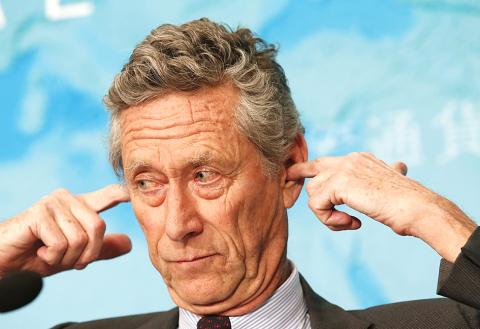The IMF made the steepest cut to its global-growth outlook in three years, with diminished expectations almost everywhere except the US more than offsetting the boost to expansion from lower oil prices.
The world economy would grow 3.5 percent this year, down from the 3.8 percent pace projected in October, the IMF said in its quarterly global outlook released late on Monday.
The Washington-based lender also cut its estimate for growth next year to 3.7 percent, compared with 4 percent in October.

Photo: EPA
The weakness, along with prolonged below-target inflation, is challenging policymakers across Europe and Asia to come up with fresh ways to stimulate demand more than six years after the global financial crisis.
Central bankers and government officials, including Bank of England Governor Mark Carney and Bank of Japan Governor Haruhiko Kuroda might talk about options when they convene this week at the World Economic Forum’s annual meeting in Davos, Switzerland.
“The world economy is facing strong and complex cross currents,” IMF chief economist Olivier Blanchard said in the text of remarks at a press briefing yesterday in Beijing. “On the one hand, major economies are benefiting from the decline in the price of oil. On the other, in many parts of the world, lower long-run prospects adversely affect demand, resulting in a strong undertow.”
The IMF cut its outlook for consumer-price gains in advanced economies almost in half to 1 percent for this year. Developing economies would see inflation this year of 5.7 percent, a 0.1 percentage point markup from October’s projections, the fund said.
The growth forecast reduction was the biggest since January 2012, when the fund lowered its estimate for expansion that year to 3.3 percent from 4 percent amid forecasts of a recession in Europe.
The IMF marked down estimates for this year for places including the eurozone, Japan, China and Latin America. The deepest reductions were in places suffering from crises, such as Russia, or for oil exporters, including Saudi Arabia.
IMF Managing Director Christine Lagarde outlined the sobering outlook in her first speech of the year last week, saying that oil prices and US growth “are not a cure for deep-seated weaknesses elsewhere.”
The US is the exception. The IMF upgraded its forecast for the world’s largest economy to 3.6 percent growth for this year, up from 3.1 percent in October.
Cheap oil, more moderate fiscal tightening and still-loose monetary policy would offset the effects of a gradual increase in interest rates and the curb on exports from a stronger dollar, the fund said.
In Europe, weaker investment would overshadow the benefits of low oil prices, a cheaper currency and the European Central Bank’s anticipated move to expand monetary stimulus by buying sovereign bonds, the IMF said.
The fund lowered its forecast for the 19-nation eurozone to 1.2 percent this year, down from 1.3 percent in October.
The ECB should go “all in” in its bond-buying program, Blanchard said in an interview with Bloomberg TV.
“We want to make sure that when there’s an announcement, that it’s as large as what the market’s expecting,” he said.
The IMF also trimmed its estimate for China’s growth to 6.8 percent, down 0.3 percentage point from October.

It was late morning and steam was rising from water tanks atop the colorful, but opaque-windowed, “soapland” sex parlors in a historic Tokyo red-light district. Walking through the narrow streets, camera in hand, was Beniko — a former sex worker who is trying to capture the spirit of the area once known as Yoshiwara through photography. “People often talk about this neighborhood having a ‘bad history,’” said Beniko, who goes by her nickname. “But the truth is that through the years people have lived here, made a life here, sometimes struggled to survive. I want to share that reality.” In its mid-17th to

State-run CPC Corp, Taiwan (CPC, 台灣中油) yesterday signed a letter of intent with Alaska Gasline Development Corp (AGDC), expressing an interest to buy liquefied natural gas (LNG) and invest in the latter’s Alaska LNG project, the Ministry of Economic Affairs said in a statement. Under the agreement, CPC is to participate in the project’s upstream gas investment to secure stable energy resources for Taiwan, the ministry said. The Alaska LNG project is jointly promoted by AGDC and major developer Glenfarne Group LLC, as Alaska plans to export up to 20 million tonnes of LNG annually from 2031. It involves constructing an 1,290km

‘MAKE OR BREAK’: Nvidia shares remain down more than 9 percent, but investors are hoping CEO Jensen Huang’s speech can stave off fears that the sales boom is peaking Shares in Nvidia Corp’s Taiwanese suppliers mostly closed higher yesterday on hopes that the US artificial intelligence (AI) chip designer would showcase next-generation technologies at its annual AI conference slated to open later in the day. The GPU Technology Conference (GTC) in California is to feature developers, engineers, researchers, inventors and information technology professionals, and would focus on AI, computer graphics, data science, machine learning and autonomous machines. The event comes at a make-or-break moment for the firm, as it heads into the next few quarters, with Nvidia CEO Jensen Huang’s (黃仁勳) keynote speech today seen as having the ability to

NEXT GENERATION: The company also showcased automated machines, including a nursing robot called Nurabot, which is to enter service at a Taichung hospital this year Hon Hai Precision Industry Co (鴻海精密) expects server revenue to exceed its iPhone revenue within two years, with the possibility of achieving this goal as early as this year, chairman Young Liu (劉揚偉) said on Tuesday at Nvidia Corp’s annual technology conference in San Jose, California. AI would be the primary focus this year for the company, also known as Foxconn Technology Group (富士康科技集團), as rapidly advancing AI applications are driving up demand for AI servers, Liu said. The production and shipment of Nvidia’s GB200 chips and the anticipated launch of GB300 chips in the second half of the year would propel